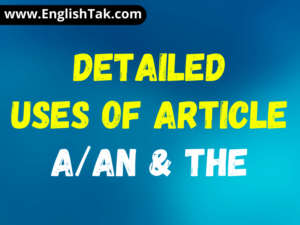![]()
Adverbs in English
Table of Contents
Adverbs in English:- An adverb is a word that modifies or describes a verb, adjective, another adverb, a preposition, conjunction or sometimes a whole sentence. It tells how, when, where, why, or to what extent an action is done.
Read More
There are several types of adverbs.
1. Adverbs of manner:- The adverbs of manner describe how something is done or happens.
Adverbs of manner बताते हैं कि कैसे कुछ किया जाता है या होता है। How से प्रश्न पूछने पर Adverb of Manner का पता चलता है।
Examples:-
She speaks quickly.
He runs slowly.
My father speaks softly.
Don’t speak English loudly.
He writes his notes beautifully.
2. Adverbs of time:- The adverbs of times describe when something happens or for how long.
The adverbs of times बताते हैं कि कब कुछ होता है या कितनी देर तक होता है। When से प्रश्न पूछने पर Adverb of Time का पता चलता है।
Examples:-
It is raining now.
She didn’t speak anything then.
My eldest brother came yesterday.
We will play a match tomorrow.
I will get my book published soon.
He often tells a lie.
3. Adverbs of place:- The adverbs of place describe where something happens or the direction in which something moves.
इस Adverb से पता चलता है कि कोई काम कहाँ होता है या किया जाता है। Where से प्रश्न पूछने से Adverb of Place का पता चलता है।
Examples:-
Come here.
Don’t go there.
He threw the ball up.
Water flows down.
We were inside when she fell from the roof.
No one was outside.
4. Adverbs of degree:- The adverbs of degree describe the intensity or extent of an action or adjective.
इस Adverb से यह पता चलता है, कि किसी Action, Adjective, या Adverb की तीव्रता किस हद तक या कितनी है। How much से प्रश्न पूछने पर Adverb of Degree का पता चलता है।
Examples:-
She is very intelligent.
He writes quite clearly.
They played extremely well.
You are totally wrong.
She hardly meets me.
5. Adverbs of frequency: The Adverbs of frequency adverbs describe how often something happens.
Adverb of Frequency से बारम्बारता का बोध कराता है यानी कि क्रिया कितनी बार हुई है।
Examples:-
He always comes late.
I never tell a lie.
They often make her cry.
We seldom play in the sun.
6. Interrogative adverbs: The Interrogative adverbs are used to ask questions about time, place, manner, or reason.
प्रश्नवाचक क्रियाविशेषण का उपयोग समय, स्थान, तरीके या कारण के बारे में प्रश्न पूछने के लिए किया जाता है।
Examples:-
When do you come late?
Where is she going now?
How do you speak English so fluently?
Why do your parents scold you?
7. Relative adverbs:- The Relative adverbs are used to introduce a subordinate clause that describes time, place, or reason.
वह Adverbs जो वाक्यों को जोड़ती है सम्बन्धवाचक क्रियाविशेषण कहलाती है।
Examples:-
I don’t know when she comes here.
Can you tell me where she goes.
Why she gets angry is not known.
Note:- It’s worth noting that some words can function as both adverbs and other parts of speech, depending on their context in a sentence. For example, the word “fast” can be an adverb, as in “She ran fast,” or an adjective, as in “She is a fast runner.”
Read More
Adverbs in English
Important Adverbs Uses
There are some adverbs that can be confusing because they have multiple meanings or are used in different ways in different contexts. Here are some examples:
1. Just:
(i) It can mean “Only,.
I just want a cup of coffee.
(ii) It can also mean “Recently.
She has just started this job.
(iii) It can also be used to emphasize a point.
I just can’t believe it.
2. Yet:
(i) It can be used to describe something that hasn’t happened up to a certain point.
I haven’t finished my homework yet.
(ii) It can also be used to mean “still” and used in negative and interrogative sentence.
I have not completed this project yet.
3. Already:
(i) It can be used to describe something that has happened before a certain time.
I have already eaten breakfast.
(ii) It can also be used to emphasize a point.
I can’t believe it’s already May.
4. Hard:
(i) It can be used to describe something that is difficult to do.
I work hard every day.
(ii) It can also be used to describe something that is done with great force or intensity.
He hit the ball hard.
5. Just about:
(i) It can be used to mean “almost,.
I just about finished my project.
(ii) It can also be used to mean “nearly,.
It’s just about time to leave.”
Read More
Adverbs in English
Confusing Pair of Adverbs
There are several pairs of adverbs in English that are often confused because they have similar meanings or are used in similar ways. Here are some examples:
1. Farther and Further: Both of these adverbs are used to show distance, but “farther” refers to physical distance, while “further” is used to describe metaphorical distance or degree.
For example:-
She can throw the ball farther than you do.
We need to discuss this matter further.
2. Fewer and Less: Both of these adverbs are used to show quantity, but “fewer” is used with countable nouns, while “less” is used with uncountable nouns.
For example:-
There are fewer apples than oranges.
There is less sugar in this recipe than in the other one.
3. Continually and Continuously: Both of these adverbs are used to show actions that are ongoing, but “continually” means repeatedly with breaks in between, while “continuously” means without interruption.
For example:-
The phone was ringing continually throughout the day.
The machine runs continuously without stopping.
4. Too and Very: Both adverbs used to modify adjectives or other adverbs, but they have different meanings and uses.
“Too” is used to indicate that something is in excess or beyond what is appropriate, desirable, or necessary. It is often used to express a negative sentiment or to indicate that something is not good.
For example:-
This cake is too sweet.
It means that the cake has more sugar than it should have, making it unpleasant or unsatisfactory.
I am too tired to go out tonight
It means that the speaker is too exhausted or fatigued to go out and have fun.
“Very,” is used to intensify an adjective or adverb and indicate a high degree of quality or quantity. It is often used to express a positive sentiment or to emphasize that something is good.
For example:-
This is a very delicious cake
It means that the cake has a high level of quality and is enjoyable to eat.
I am very happy to see you
It means that the speaker is extremely pleased to see the person they are addressing.
In summary, “too” is used to indicate that something is in excess or beyond what is appropriate, while “very” is used to intensify an adjective or adverb and indicate a high degree of quality or quantity.
Read More
Adverbs in English
5. Yet and Still: Both adverbs that can be used to convey a sense of continuation or persistence, but they are used in different ways.
“Yet” is used to describe something that hasn’t happened up to a certain point, but it is expected or anticipated to happen in the future.
For example:-
I haven’t finished my homework yet
It means that the speaker hasn’t completed their homework up until this point, but they plan or expect to do so in the near future.
I haven’t heard back from the job interview yet.
It means that the speaker hasn’t received any response from the interview process up until now, but they anticipate or hope to hear back soon.
“Still” is used to describe something that continues to happen or exist without change, despite other factors that might suggest otherwise.
For example:-
I am still waiting for my tea to arrive
It means that the speaker has been waiting for their tea for some time, but it hasn’t arrived yet.
She still loves to dance.
It means that the person has loved dancing in the past and continues to love it in the present, despite the passage of time.
In summary, “Yet” is used to describe something that is anticipated to happen in the future, while “Still” is used to describe something that persists without change in the present.
6. Fairly and Rather: Both adverbs that modify the degree or intensity of an adjective or adverb, but they are used in slightly different ways.
“Fairly” is used to indicate a moderate or reasonable degree of something. It suggests that something is not extreme or excessive, but is still significant or noticeable and has a positive meaning.
For example:-
She is fairly tall.
It means, she is taller than average, but acceptable.
The movie was fairly good
It means, the movie was enjoyable, but not amazing or exceptional.
“Rather” is used to indicate a higher degree of something than expected or typical. It suggests that something is somewhat surprising or unexpected. Sometimes, it is used in the negative sense.
For example:-
He is rather intelligent
It means, he is more intelligent than expected.
The food was rather spicy
It means, the level of spiciness was higher than expected or than what is typical for that type of food.
Top Grammar Posts on English Grammar
Important Fixed Preposition – Day – 1
Difference between Few / Little / Less / Fewer in Hindi
Parts of Speech in Hindi – Part-1
Subject-Verb Agreement | Grammar Rules
Narration Practice Exercise | Assertive Sentence | Day-1





